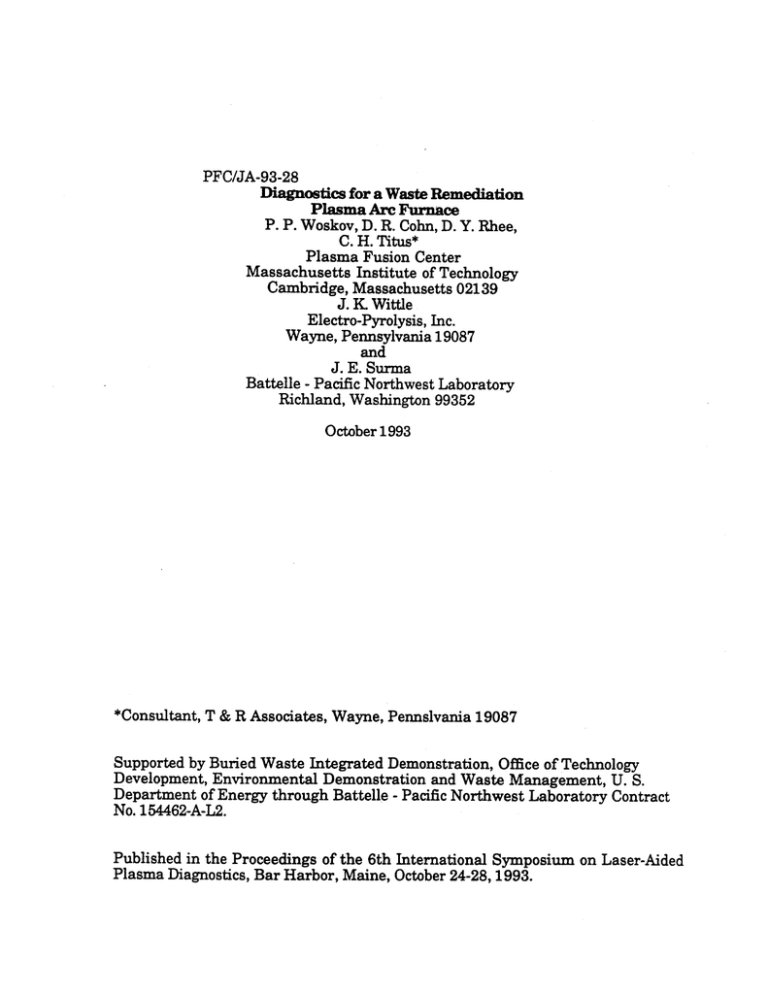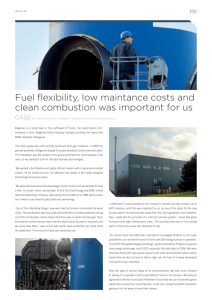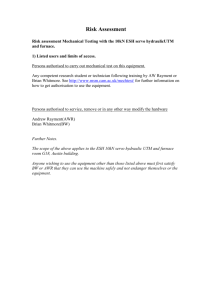PFC/JA-93-28 J.
advertisement

PFC/JA-93-28 Diagnostics for a Waste Remediation Plasma Arc Furnace P. P. Woskov, D. R. Cohn, D. Y. Rhee, C. H. Titus* Plasma Fusion Center Massachusetts Institute of Technology Cambridge, Massachusetts 02139 J.K. Wittle Electro-Pyrolysis, Inc. Wayne, Pennsylvania 19087 and J. E. Surma Battelle - Pacific Northwest Laboratory Richland, Washington 99352 October 1993 *Consultant, T & R Associates, Wayne, Pennslvania 19087 Supported by Buried Waste Integrated Demonstration, Office of Technology Development, Environmental Demonstration and Waste Management, U. S. Department of Energy through Battelle - Pacific Northwest Laboratory Contract No. 154462-A-L2. Published in the Proceedings of the 6th International Symposium on Laser-Aided Plasma Diagnostics, Bar Harbor, Maine, October 24-28,1993. Presented at the 6th InternationalSymposium on Laser-Aided PlasmaDiagnostics, October 24-28, 1993, Bar Harbor,Maine. Diagnostics for a Waste Remediation Plasma Arc Furnace* P. P. Woskov, D. R. Cohn, D. Y. Rhee, and C. H. Titus** Plasma Fusion Center, Massachusetts Institute of Technology, Cambridge, MA 02139 J. K. Wittle Electro-Pyrolysis, Inc. Wayne, PA 19087 J. E. Surma Pacific Northwest Laboratory, Richland, WA 99352 Abstract: A graphite electrode dc arc plasma furnace is being developed to remediate contaminated soils in the DOE complex. Real time, continuous diagnostics are needed to monitor and control the entire waste remediation process from input to output. Laboratory feasibility tests have been carried out on an active millimeter-wave radiometer for spatially resolved furnace temperature measurements and a microwave torch plasma for trace metals measurements in the off-gas stream. 1. Introduction The development of technologies to remediate hazardous waste sites is a growing area. The U. S. Department of Energy (DOE) has approximately 4,000 contaminated sites covering tens of thousands of acres, as identified in the current DOE Environmental Restoration and Waste Management Five-Year Plan [1]. These wastes include low-level, high-level, and transuranic radioactive wastes; and soils contaminated with metals, volatile organic compounds (VOCs), sludges, oils, and combustibles. The five year plan has stated that DOE must develop new technologies to assist it in cleaning up these sites in faster, better, safer, and cheaper ways. The development of such technologies have broad ranging application to commercial and municipal waste sites as well. A "National Laboratory-University-Industry" three party collaboration was established between Pacific Northwest Laboratory (PNL), Massachusetts Institute of Technology (MIT), and Electro-Pyrolysis, Inc. (EPI) to develop graphite electrode DC plasma arc technology for the treatment of buried wastes [2,3]. This program now includes the development of advanced diagnostic systems to characterize performance, optimize operation, and control the plasma arc furnace. The DC graphite arc furnace technology has demonstrated the capability of forming a high quality, nonleachable glass from high melting point (1400-1600'C) waste and soil typical of DOE waste sites. Supported by Buried Waste Integrated Demonstration, Office of Technology Development, Environmental Demonstration and Waste Management, U.S.D.O.E. ** Consultant, T&R Associates, Wayne, PA -1- In addition, the high temperature region (up to 6000'C) around the DC arc can destroy organic species and vapors that evolve from the material being processed. Following successful feasibility tests in a 300 kW, 100 pound batch processing Mark I furnace, a pilot-scale Mark II furnace with up to 1 MW and 500 pound per hour continuous processing capability has been constructed at the MIT Plasma Fusion Center. Fig. 1 shows the major features of Mark II which has internal dimensions of 0.9 m diameter by 1.4 m high. It is completely sealed and purged with nitrogen. A unique feature is the coaxial arrangement of the graphite electrodes with a 15 cm diameter inner electrode and a 25 cm i.d. by 36 cm o.d. outer electrode. This design allows easy furnace start up by first running an arc between the electrodes to initially melt the material being processed and then transferring the arc to the melt for more efficient treatment. Not shown in Fig. 1 are large 1.0 x 0.7 m rectangular ports located 900 circumferentially from the furnace feed chamber and glass discharge section. These ports are a unique feature of Mark II to accommodate diagnostics. Diagnostics are a crucial part of this project since new waste remediation technologies will not be acceptable unless they are proven to be an improvement over older technologies and absolutely safe to the environment. Diagnostics are needed to monitor the entire waste remediation process from input to output, as well as internal furnace parameters. In general, accurate, reliable, real time diagnostics are lacking for many of the parameters of interest. Table 1 identifies important parameters of interest and applicable diagnostic techniques. So far we have undertaken laboratory feasibility tests of the first two diagnostics listed and these are described below. Table 1. WASTE REMEDIATION PROCESS DIAGNOSTICS Obectives Approach Spatially Resolved Furnace Temperature Active Millimeter-Wave Radiometer Trace Metal Content in Off-Gas Microwave Torch Sensor Off-Gas Molecular Content Infrared/Millimeter Wave Spectroscopy Feed and Slag Characterization Laser Ablation Spectroscopy Particle Size/Density Laser Scattering Off-Gas Velocity Laser Doppler Scattering II. Active Millimeter-Wave Radiometer Knowledge of the internal temperature distribution is a key parameter for monitoring furnace performance and necessary for furnace optimization. However, -2- present temperature measurement instrumentation have a number of short comings which make them unreliable, inaccurate, or hazardous for use inside the hot hostile environment of a furnace. For example, infrared pyrometers can not view through smoky, hazy, and/or particle filled off-gases, their view can be further blocked by deposits on exposed viewing windows, and knowledge of surface emissivity is required to accurately interpret the temperature. Other temperature sensors such as thermocouples, which are directly exposed to the harsh furnace environment, have high failure rates and require electrical wires being brought into the furnace which would require additional seals and could be a hazard in electric arc furnace applications. We have tested, and are implementing on Mark II, an active millimeter-wave radiometer which overcomes the limitations of currently available instrumentation for spatially resolved temperature measurements. Millimeter-waves are sufficiently long that they can penetrate visibly opaque atmospheres such as fog and smoke and are minimally effected by surface deposits on window and mirror surfaces, yet they are still short enough for good spatial resolution. Furthermore, a probe beam can be readily superimposed onto the radiometer field-of-view to provide a surface reflection measurement. Such a measurement is important to determine the surface emissivity which must be known to interpret the hot surface emission as a temperature when the surrounding surfaces are not in thermal equilibrium [4]. Also, it could provide some information on surface deposition chemistry inside the furnace. Millimeter-waves are ideal for this probe function because in addition to good propagation inside the furnace atmosphere, optical surfaces are not required for a spectrally reflected beam. The laboratory test setup for an active millimeter-wave radiometer is illustrated in Figure 2. A 135 GHz heterodyne receiver with a double-sideband-bandwidth (DSB) of 3.0 GHz and a noise temperature of 28,000 K was used. The chopper blades were covered with a millimeter-wave absorbing material [5] and acted as a room temperature black-body reference. With a lock-in amplifier integration time constant of 1.25 seconds, temperature deviations from room temperature as low as 10 *C could be detected. There is no effective upper limit for measurement of temperatures relevant to furnace operations. An Impatt diode beam was superimposed onto the receiver fieldof-view via a low reflectivity (<10%) Teflon beamsplitter. The Impatt diode was rapidly frequency swept over the receiver bandwidth to average out coherent interference effects. In this test setup the hot surface emission and reflection measurements were not simultaneous. The emission was measured with the Impatt diode off and chopper on, and the reflection was measured with the Impatt on and chopper off. A liquid nitrogen black-body and a gold mirror were used to absolutely calibrate the temperature and reflection measurements, respectively. The active millimeter-wave radiometer was tested with one of the alumina bricks, GP Green AD-99, which will line the interior surface of Mark II. A table top oven, Omegalux Model LMF-M525, was used to heat this brick to a high temperature after which the oven door was opened and the brick surface was monitored during cool -3- down. The surface emissivity (s) was determined using the assumption e = 1 - R, where R is the measured reflection. The plotted results in Figure 3 show that the emissivity of this brick at 135 GHz is constant at about 0.88 for temperatures of up to 750 *C. This is a sufficient deviation from the ideal black-body emissivity of 1.00 that it must be taken into account for an accurate temperature determination by radiometry. In Mark II much higher temperatures will be achieved, surface deposits could form, and due to continuous feed the internal surfaces will not be in thermal equilibrium. Therefore, an active radiometer is necessary for temperature measurements. The radiometer being implemented on Mark II has a novel waveguide optics system which is compatible with the high furnace temperatures and can vertically scan the interior surface from the melt to the ceiling. Also it will be capable of simultaneous emission and emissivity measurements. III. Microwave Torch Trace Metals Diagnostic The emission of metals in the off-gas stream of waste burning and remediation furnaces is an important environmental issue. The U. S. Environmental Protection Agency (EPA) has regulations that limit the emission of 12 metals (Sb, Ba, Pb, Hg, Ag, TI, As, Cd, Cr, Be, Ni, Se). To this list we must add a number of radioactive metals because of the ultimate intended application of the Mark II furnace technology. Reliable continuous emission monitors for metals are not currently available. Generally, samples of the off-gas stream must be taken to a laboratory for detailed analysis. A waste furnace's metals emission is presently controlled by keeping the maximum metals feed rate below that during trial test runs. It would be much more desirable to be able to monitor metals emission in real time and use such data for furnace control. We have tested the feasibility of using a microwave torch plasma in the off-gas stream to atomize and excite the trace metals for real time atomic emission spectroscopy (AES). Plasmas such as inductively coupled plasmas (ICP) and microwave induced plasmas (MIP) are routinely used in the laboratory for trace element analysis [6]. By suitable design of a microwave plasma device and by going to high power levels (>0.5 kW) we plan to demonstrate a real time in situ trace metals sensor. Such a sensor would be robust in the off-gas flow stream, would atomize metals condensed on particulates as well as those in the vapor phase, and could operate continuously. The feasibility of this approach to trace metals sensing was tested using the experimental arrangement shown in Fig. 4. An ASTeX 1.5 kW, 2.45 GHz microwave system was used to generate the plasma in a flow of ambient laboratory air or nitrogen. The plasma breakdown occurs 1/4% from the shorted end of a rectangular waveguide with outside dimensions of 7.6 x 3.8 cm (WR-284 guide). A small 3 mm diameter hole in the shorted end of the waveguide allowed the plasma emission to be viewed by -4- a SPEX Model THR-640, 0.64 m Czerny-Turner spectrometer with a 2400 g/mm grating and a 512 silicon diode array from Princeton Instruments. Figure 4 shows the setup for trace mercury measurements. Mercury vapor was introduced into the plasma by blowing nitrogen or air through a Pyrex glass u-tube with a drop of mercury in the bottom. The trace mercury measurements were calibrated by using a commercial Bacharach Instruments Company Mercury Sniffer obtained from the MIT safety office. Fig. 5 shows a typical spectrum at the 253.65 nm transition of neutral mercury in nitrogen gas flow of 28 1/min., 0.55 kW of microwave power, and a measured mercury concentration of 0.04 mg/m 3 (6 ppb) at point A in Fig. 4. This spectrum was obtained in 0.17 seconds. The good signal to noise ratio indicates that mercury concentrations as low as 0.5 ppb could be detected in a nitrogen gas flow. In air flow plasmas this sensitivity degraded to about 3 ppb due to an increase in the UV background. Both these measured sensitivities are below the EPA threshold limit value of 6 ppb and demonstrate the potential usefulness of this approach to real time trace metals monitoring. Additional tests were carried out with fine iron particulates (147 im dia.) and particulates obtained in the off-gas stream of earlier Mark I tests. These tests were not quantitative but did demonstrate the robustness of the microwave plasma to the presence of particulates, the atomization and excitation of the particulates, and good sensitivity to trace metals (a Mn impurity was clearly detected in a 99% pure iron particulate). Future work will focus on evolving the microwave device to a configuration that can be adapted to the off-gas stream of Mark II and other furnaces. Another area of emphasis will be the development of an in situ calibration technique. References 1. USDOE, EnvironmentalRestoration and Waste Management Five Year Plan, DOE IS00097P, Vol. I & II, United States Department of Energy, Washington, D.C., 1993. 2. J. E. Surma, D. R. Cohn, D. L. Smatlak, P. Thomas, P. P. Woskov, C. H. Titus, J. K. Wittle, and R. A. Hamilton, Graphite Electrode DC Arc Technology Development for Treatment of Buried Wastes, PNL-SA-21891, Pacific Northwest Laboratory, Richland, Washington, 1993. 3. J. K. Wittle, C. H. Titus, R. A. Hamilton, D. R. Cohn, D. L. Smatlak, P. Thomas, P. P. Woskov, and J. E. Surma, DC GraphiteArc Furnace and DiagnosticSystems for Soils, Hazardous Waste and Hazardous Materials, to be published, 1993. 4. F. P. Incropera and D. P. DeWitt, Intoduction to Heat Transfer, 2nd Ed., Chap. 12, John Wiley & Sons, New York, 1990. 5. Eccosorb made by Emerson Cuming. 6. M. W. Blades, P. Banks, C. Gill, D. Huang, C. Le Blanc, and D. Liang, IEEE Trans. on Plasma Sci., Vol. 19, pp. 1090-1113, 1991. -5- -7--,-Impatt G-.s Source Oven Var. Beamsplitter Atten. Millimeter Wave Receiver Furnace Chopper Brick DVM Ref. 1.Go ". , . . . . . . . . . . . Lock-in Amp. . Figure 1. Mark II, graphite electrode dc arc furnace. Figure 2. Experimental test setup for an active millimeter-wave radiometer. Emissivity of Alumina Brick at 135 GHz plasma A- A t- from 25GHz 0.5 meter 0.8. -- ---------------- Z W0.7 - ......... -- -... lenai nitrogen air or flow -- - ---.. -- .- -- - waveguide qUartZ - Three Experimental Runs GP Green AD99 Alumina Brick .. .............. ................ 00 0 150 ____ 300 ....... ............ I 450 600 Zalumina .. ....... or air flow 750 mercury drop Temperature (*C) Figure 3. Measured emissivity of an alumina furnace brick using a 135 GHz active radiometer. -6- Figure 4. Experimental setup for test of a microwave torch trace metals diagnostic. Mercury Detection in Microwave Plasma 588 .- 4.' In 48 Nitrogen Plasma 550 Watts - Hg 1 253.65 nm 488 0) .4-. 300 0) 0) 200 Mercury concentration - 0.04 mg/m 3 188 - lsv 256.7 255.2 253.8 252.3 258.8 249.3 1 Wavelength (nm) Figure 5. Detected spectrum in a nitrogen torch plasma having a trace mercury concentration of approximately 5 ppb. -7-






